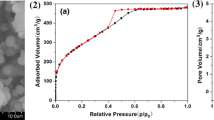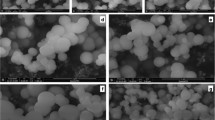Abstract
Mesoporous silica network nanotubes were fabricated using both organic and inorganic templates such as citric acid (CA), cetyltrimethylammonium bromide (CTAB), and sodium bicarbonate (SBC). The phase analysis of synthesized silica network was confirmed by X-ray diffractometer (XRD) analysis, and the present functional groups were revealed by Fourier Transform Infrared Spectroscopy (FTIR) and the formation of tubular morphology was analyzed by transmission electron microscopy (TEM). The mesoporous nature of each template sample was studied using Brunauer–Emmett–Teller (BET) instrument. The surface area and porous size were calculated successfully for fabricated silica network nanotubes.






Similar content being viewed by others
References
Wang, J. X., Wen, L. X., Wang, Z. H., Wang, M., Shao, L., & Chen, J. F. (2004). Facile synthesis of hallow silica nanotubes and their applications as supports for immobilization of silver nanoparticles. Scriptamat, 50, 1035–1039.
Chen, X., Klingeler, R., Kath, M., El Gendy, A. A., Cendrowski, K., Kalenczuk, R. J., & Palen, E. B. (2012). Magnetic silica nanotubes: Synthesis, drug release, and feasibility for magnetic hyperthermia. Applied Materials & Interfaces, 4, 2303–2309.
Guo, L., Shen, L., Chen, S., Wei, A., Huang, D., Osaka, A., & Chen, W. (2019). Naturally derived silk fibroin/gelatin composites as novel sacrificial template for synthesis of silica nanotubes with controllable size and their in vitro biocompatibility. Materials Letters., 251, 89–93.
Xu, S., Wang, Y., Qi, W., Su, R., & He, Z. (2018). Design of silica nanostructures with tunable architectures templated by ferrocene peptides. ChemistrySelect, 3, 4939–4943.
Calzo´n, J. A. G., & Garcı´a, M. E. D. (2012). Synthesis and analytical potential of silica nanotubes. Trends Analyt Chemistry, 35, 27–38.
Li, J., Wang, Y., Zheng, X., Zhang, Y., Sun, C., Gao, Y., Jiang, T., & Wang, S. (2015). The synthesis and application involving regulation of the drug release from mesoporous silica nanotubes. Applied Surface Science, 330, 374–382.
Tran, H. Q., Bhave, M., & Yu, A. (2020). Current advances of hollow capsules as controlled drug delivery systems. Chemistry Select, 5, 5537–5555.
Hu, J. Q., Meng, X. M., Jiang, Y., Lee, C. S., & Lee, S. T. (2003). Fabrication of germanium-filled silica nanotubes and aligned silica nanofibers. Advanced Materials, 15, 70–73.
Ren, L., Simmons, T. J., Lu, F., Rahmi, O., & Kotha, S. P. (2014). Template free and large-scale fabrication of silica nanotubes with centrifugal jet spinning. Chemical Engineering Journal, 254, 39–45.
Chen, S., Zhang, Q., Jia, L., Du, X., & Hanagata, N. (2015). A facilely controlled length, cytotoxicity, lengthdependent and cell type-dependent cellular uptake of silica nanotubes and their applications in the delivery of immunostimulatory CpG Oligodeoxynucleotides. Journal of Materials Chemistry B. https://doi.org/10.1039/c5tb01270h
Matsuura, Y., Hirano, T., & Sakai, K., (2014). Friction torque reduction by ultrasonic vibration and its application to electromagnetically spinning viscometer. Japanese Journal of Applied Physics 53, 07KC12–1 to 07KC12–4.
Chen, S., Osaka, A., & Hanagata, N. (2011). Collagen-templated sol–gel fabrication, microstructure, in vitro apatite deposition, and osteoblastic cell MC3T3-E1 compatibility of novel silica nanotube compacts. Journal of Materials Chemistry, 21, 4332–4338.
Muhr, H. J., Krumeich, F., Schönholzer, U. P., Bieri, F., Niederberger, M., Gauckler, L. J., & Reinhard Nesper, R. (2000). Vanadium oxide nanotubesða new flexible vanadate nanophase. Advanced Materials, 12(3), 231–234.
Sun, L., Wang, Y., Jiang, T., Zheng, X., Zhang, J., Sun, J., Sun, C., & Wang, S. (2013). Novel chitosan-functionalized spherical nanosilica matrix as an oral sustained drug delivery system for poorly water-soluble drug carvedilol. Applied Materials & Interfaces, 5, 103–113.
Wang, S. (2009). Ordered mesoporous materials for drug delivery. Microporous and Mesoporous Materials, 117, 1–9.
Vona, D., Cicco, S. R., Ragni, R., Leone, G., Presti, M. L., & Farinola, G. M. (2018). Biosilica/polydopamine/silver nanoparticles composites: New hybrid multifunctional heterostructures obtained by chemical modification of Thalassiosira weissflogii silica shells. MRS Communications. https://doi.org/10.1557/mrc.2018.103
Rahmani, S., Akrout, A., Budimir, J., Aggad, D., Daurat, M., Godefroy, A., Nguyen, C., Largot, H., Bobo, M. G., Raehm, L., Durand, J. O., & Charnay, C. (2018). Hollow organosilica nanoparticles for drug delivery. Chemistry Select, 3, 10439–10442.
Wu, Z., Li, Y., Li, J., Wang, M., & Wang, Z. (2020). Interaction and properties of the synthesized anionic surfactant with CTAB: An experimental and theoretical investigation. Chemistry Select, 5, 1663–1670.
Acknowledgements
The authors gratefully acknowledge the Indian Council of Medical Research (ICMR) for financial support in the form of Senior Research Fellow (SRF) [Grant no. 45/22/2019-Nan/BMS].
Author information
Authors and Affiliations
Contributions
Logesh Mahendran helped to characterize and analyze application part, and wrote the article. Abimanyu Ravichandran worked on the synthesis part. A.M. Ballamurugan has given guidance to the overall work on this manuscript. All authors read and approved the final manuscript.
Corresponding author
Ethics declarations
Ethics Approval
Not applicable.
Consent to Participate
Not applicable.
Consent for Publication
All authors consented to the publication of this work. Authors all confirm the permission of publication for this study.
Competing interests
The authors declare that they have no competing interests.
Additional information
Publisher’s Note
Springer Nature remains neutral with regard to jurisdictional claims in published maps and institutional affiliations.
Supplementary Information
Below is the link to the electronic supplementary material.
Rights and permissions
About this article
Cite this article
Mahendran, L., Ravichandran, A. & Ballamurugan, A.M. Organic and Inorganic Template-Assisted Synthesis of Silica Nanotubes and Evaluation of Their Properties. Appl Biochem Biotechnol 194, 167–175 (2022). https://doi.org/10.1007/s12010-021-03740-4
Received:
Accepted:
Published:
Issue Date:
DOI: https://doi.org/10.1007/s12010-021-03740-4




